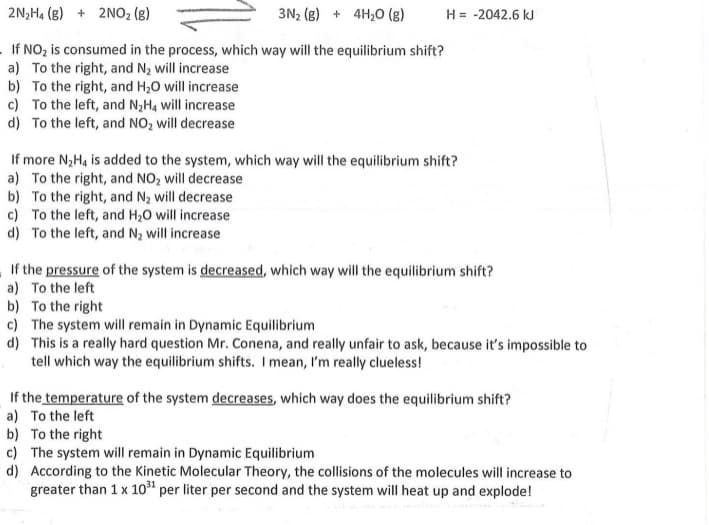2N3H, (g) + 2NO, (8) 3N, (g) + 4H,0 (g) H= -2042.6 kJ If NO, is consumed in the process, which way will the equilibrium shift? a) To the right, and N2 will increase b) To the right, and H,0 will increase c) To the left, and N,H, will increase d) To the left, and NO, will decrease If more N;H, is added to the system, which way will the equilibrium shift? a) To the right, and NO, will decrease b) To the right, and N2 will decrease c) To the left, and H,0 will increase d) To the left, and N2 will increase If the pressure of the system is decreased, which way will the equilibrium shift? a) To the left b) To the right c) The system will remain in Dynamic Equilibrium d) This is a really hard question Mr. Conena, and really unfair to ask, because it's impossible to tell which way the equilibrium shifts. I mean, I'm really clueless!
2N3H, (g) + 2NO, (8) 3N, (g) + 4H,0 (g) H= -2042.6 kJ If NO, is consumed in the process, which way will the equilibrium shift? a) To the right, and N2 will increase b) To the right, and H,0 will increase c) To the left, and N,H, will increase d) To the left, and NO, will decrease If more N;H, is added to the system, which way will the equilibrium shift? a) To the right, and NO, will decrease b) To the right, and N2 will decrease c) To the left, and H,0 will increase d) To the left, and N2 will increase If the pressure of the system is decreased, which way will the equilibrium shift? a) To the left b) To the right c) The system will remain in Dynamic Equilibrium d) This is a really hard question Mr. Conena, and really unfair to ask, because it's impossible to tell which way the equilibrium shifts. I mean, I'm really clueless!
Chemistry: An Atoms First Approach
2nd Edition
ISBN:9781305079243
Author:Steven S. Zumdahl, Susan A. Zumdahl
Publisher:Steven S. Zumdahl, Susan A. Zumdahl
Chapter12: Chemical Equilibrium
Section: Chapter Questions
Problem 99CP
Related questions
Question

Transcribed Image Text:2N,H4 (g) + 2NO2 (g)
3N2 (g) + 4H,0 (g)
H = -2042.6 kJ
If NO, is consumed in the process, which way will the equilibrium shift?
a) To the right, and N2 will increase
b) To the right, and H20 will increase
c) To the left, and N,H, will increase
d) To the left, and NO, will decrease
If more N;H, is added to the system, which way will the equilibrium shift?
a) To the right, and NO, will decrease
b) To the right, and N2 will decrease
c) To the left, and H,0 will increase
d) To the left, and N2 will increase
If the pressure of the system is decreased, which way will the equilibrium shift?
a) To the left
b) To the right
c) The system will remain in Dynamic Equilibrium
d) This is a really hard question Mr. Conena, and really unfair to ask, because it's impossible to
tell which way the equilibrium shifts. I mean, l'm really clueless!
If the temperature of the system decreases, which way does the equilibrium shift?
a) To the left
b) To the right
c) The system will remain in Dynamic Equilibrium
d) According to the Kinetic Molecular Theory, the collisions of the molecules will increase to
greater than 1 x 10" per liter per second and the system will heat up and explode!
Expert Solution
This question has been solved!
Explore an expertly crafted, step-by-step solution for a thorough understanding of key concepts.
This is a popular solution!
Trending now
This is a popular solution!
Step by step
Solved in 3 steps with 1 images

Knowledge Booster
Learn more about
Need a deep-dive on the concept behind this application? Look no further. Learn more about this topic, chemistry and related others by exploring similar questions and additional content below.Recommended textbooks for you

Chemistry: An Atoms First Approach
Chemistry
ISBN:
9781305079243
Author:
Steven S. Zumdahl, Susan A. Zumdahl
Publisher:
Cengage Learning

Chemistry
Chemistry
ISBN:
9781305957404
Author:
Steven S. Zumdahl, Susan A. Zumdahl, Donald J. DeCoste
Publisher:
Cengage Learning

Introductory Chemistry: A Foundation
Chemistry
ISBN:
9781337399425
Author:
Steven S. Zumdahl, Donald J. DeCoste
Publisher:
Cengage Learning

Chemistry: An Atoms First Approach
Chemistry
ISBN:
9781305079243
Author:
Steven S. Zumdahl, Susan A. Zumdahl
Publisher:
Cengage Learning

Chemistry
Chemistry
ISBN:
9781305957404
Author:
Steven S. Zumdahl, Susan A. Zumdahl, Donald J. DeCoste
Publisher:
Cengage Learning

Introductory Chemistry: A Foundation
Chemistry
ISBN:
9781337399425
Author:
Steven S. Zumdahl, Donald J. DeCoste
Publisher:
Cengage Learning

Chemistry for Engineering Students
Chemistry
ISBN:
9781337398909
Author:
Lawrence S. Brown, Tom Holme
Publisher:
Cengage Learning

Chemistry: Principles and Reactions
Chemistry
ISBN:
9781305079373
Author:
William L. Masterton, Cecile N. Hurley
Publisher:
Cengage Learning
